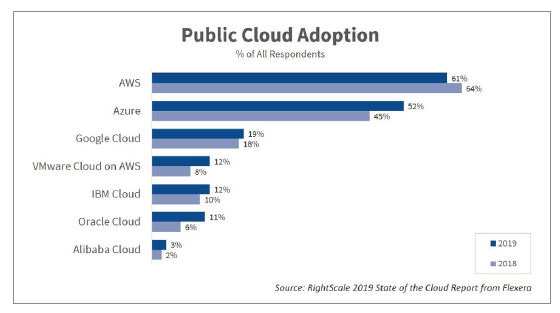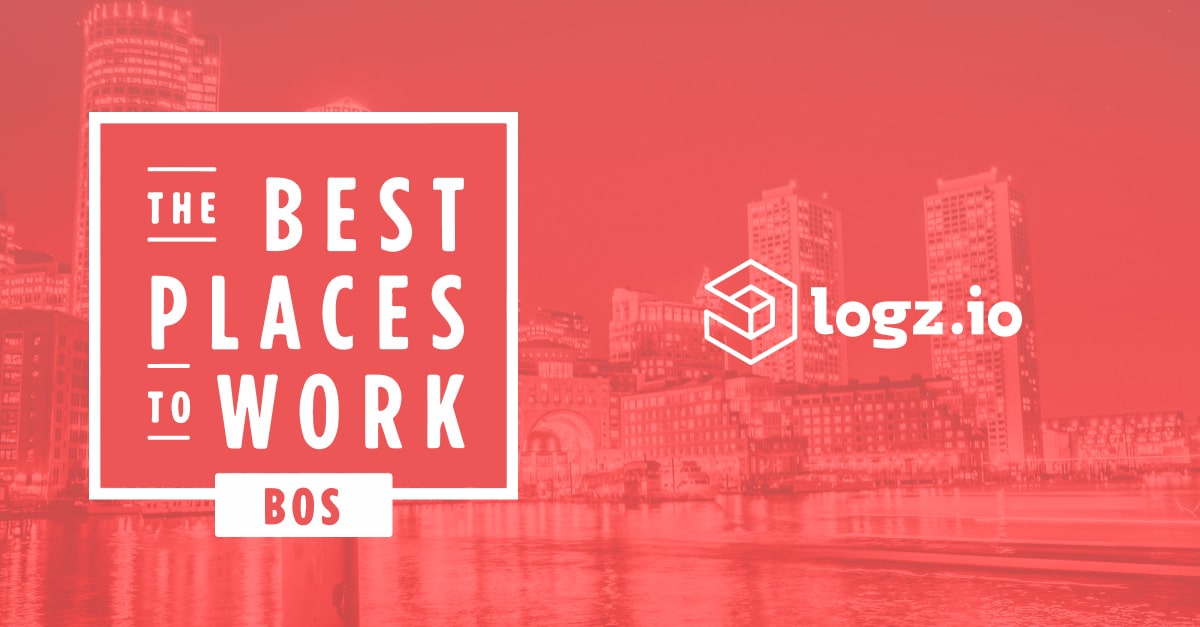
Cloud Comparison: Oracle, IBM, Alibaba
May 2, 2019
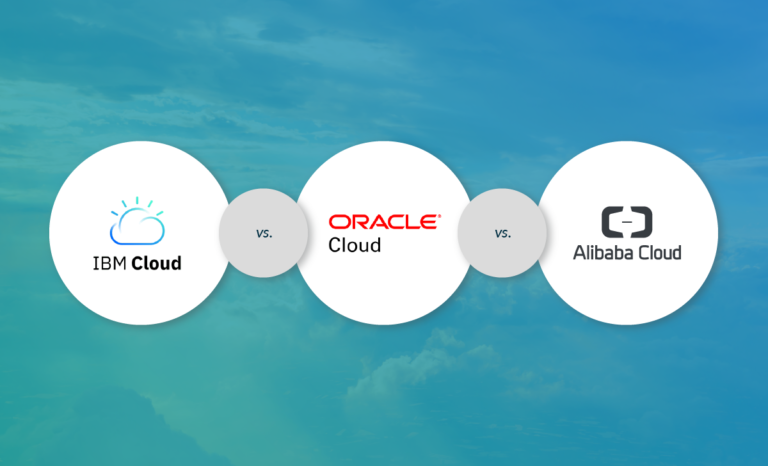
Each year we eagerly await the publication of the RightScale (now Flexera) State of the Cloud report to see which technologies and players are trending in the cloud ecosystem. In this year’s report (2019) one of the interesting takeaways is that in 2018 public cloud spending grew three times faster than private cloud and companies intend to spend almost 25% more on public cloud in 2019 than they did in 2018. As far as scope goes, 13% are already spending $12+ million annually on public cloud services and 50% more than $1.2 million each year.
In terms of where all these budgets are being spent, the following graph is enlightening:
For the first time AWS’ market share is expected to shrink somewhat in 2019 with all of the other public cloud providers expanding. Most notably, Microsoft Azure’s share is forecast to grow by 15–16%, while Oracle Cloud’s penetration will almost double in 2019. In fact, all three of the cloud service providers that we compare in this article (Oracle Cloud, IBM Cloud, and Alibaba Cloud) are expected to grow. Among these three Gartner Peer Insights ranks Alibaba Cloud the highest in terms of willingness to recommend (84%), followed by Oracle Cloud at 68%, and IBM Cloud at 54%. More on the subject:
IBM Cloud and Oracle Cloud emerged out of venerable business software corporations while Alibaba Cloud (like AWS) grew out of the monetization of a very large marketplace’s existing cloud infrastructure. In this article, we compare the three cloud service providers across infrastructure, databases (SQL and NoSQL), management and developer tools, logging/monitoring tools and services, and security and compliance. We’ll also compare their support for advanced data technologies (analytics, machine learning, artificial intelligence) as well as next-generation app architectures (containers, microservices, serverless). From the get-go we would like to express our gratitude to Ilyas F. for his excellent, comprehensive, and up-to-date (as of March 2019) comparison of the six major cloud providers.
Infrastructure Resources
The following table compares the three providers across a number of infrastructure parameters. A region is a geographic area while an availability zone is an isolated data center within a region:
Alibaba
IBM
Oracle
Availability zones
56
18
13
Regions
19
6
5
Storage
- Object, block and file storage
- Object Storage Archive
- Object, block and file storage
- Archive Storage
Compute
Network
- Virtual Private Cloud
- VPN Gateway
- Content Delivery Network
- Cloud DNS
- Express Connect (private connectivity)
- Server Load Balancer
- Virtual Private Cloud
- VPN
- Content Delivery Network
- Internet Services
- Direct Link
- Local/IBM Cloud load balancing, Citrix NetScaler VPX
All three providers provide solid storage, compute, and network infrastructures, with good support for hybrid clouds. Although we did not conduct a detailed price comparison, it’s clear that price is not a differentiator. The only area in which there is a noticeable difference is that Alibaba is the only provider with an extensive infrastructure in Asia—with seven regions in mainland China alone and another seven throughout Asia Pacific. IBM does offer regions in Japan and in Australia, but Oracle is focused entirely on Europe and North America.
Data Services
Data is the name of the game these days and cloud customers expect the providers to provide a full range of services for managing structured and unstructured data, migrating on-premises databases smoothly to the cloud, warehousing, and support for analytics. The following table summarizes the key data services offered by the three providers:
Alibaba
IBM
Oracle
SQL
- Db2,Db2 Hosted
- Informix
- Compose for
PostgreSQL, MySQL
Time Series database
HiTSDB(High-Performance Time Series Database)
NoSQL Database supports time series
In-Memory data store
Oracle Database 12c Release 2 running on Oracle Cloud
Alibaba’s cloud-native database services are the only ones that are exclusively cloud-based. IBM and Oracle have adapted their legacy DBMSes to run as hosted cloud services. As shown in a historical ranking graph generated in April 2019, Oracle and IBM still hold commanding positions, but the popularity of Alibaba’s DB services is growing dramatically and is starting to close the gap.
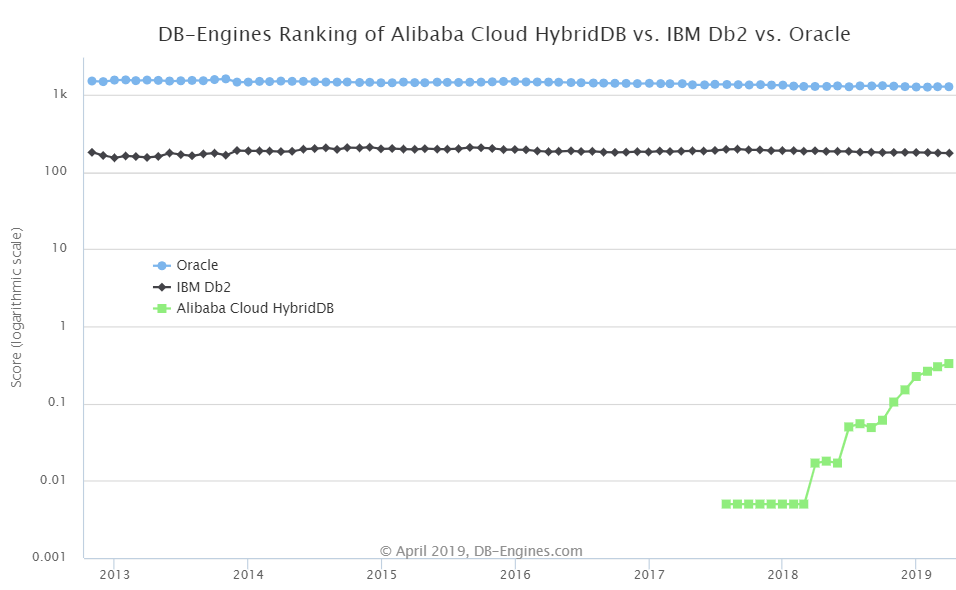
Figure 2: Alibaba’s cloud-native DB is rapidly gaining in popularity. DB-Engines
Management & Developer Tools
It can be very challenging to develop and deploy apps on the cloud, not to mention managing cloud usage across multiple accounts or multicloud and hybrid infrastructures. All of the public cloud providers provide toolchains and dashboards to make these tasks easier.
Alibaba
IBM
Oracle
Developer Services
- Active Deploy
- Continuous Delivery
- Delivery Pipeline
- Globalization Pipeline
- Track & Plan
SDKs
- Visual Builder
- API Catalog
- Packs for Eclipse and Netbeans
Management Consoles/CLI
Resource / Configuration Inventory
Server Automation
- Orchestration Cloud Service
- Oracle Managed Cloud Services
The chart below, created from Gartner Peer Insights data, shows that the Alibaba Cloud is consistently ranked higher than IBM Cloud in Developer Services, DevOps Enablement, and Management Tools. The same is true for Oracle Cloud except for Developer Services, where they are ranked the same.
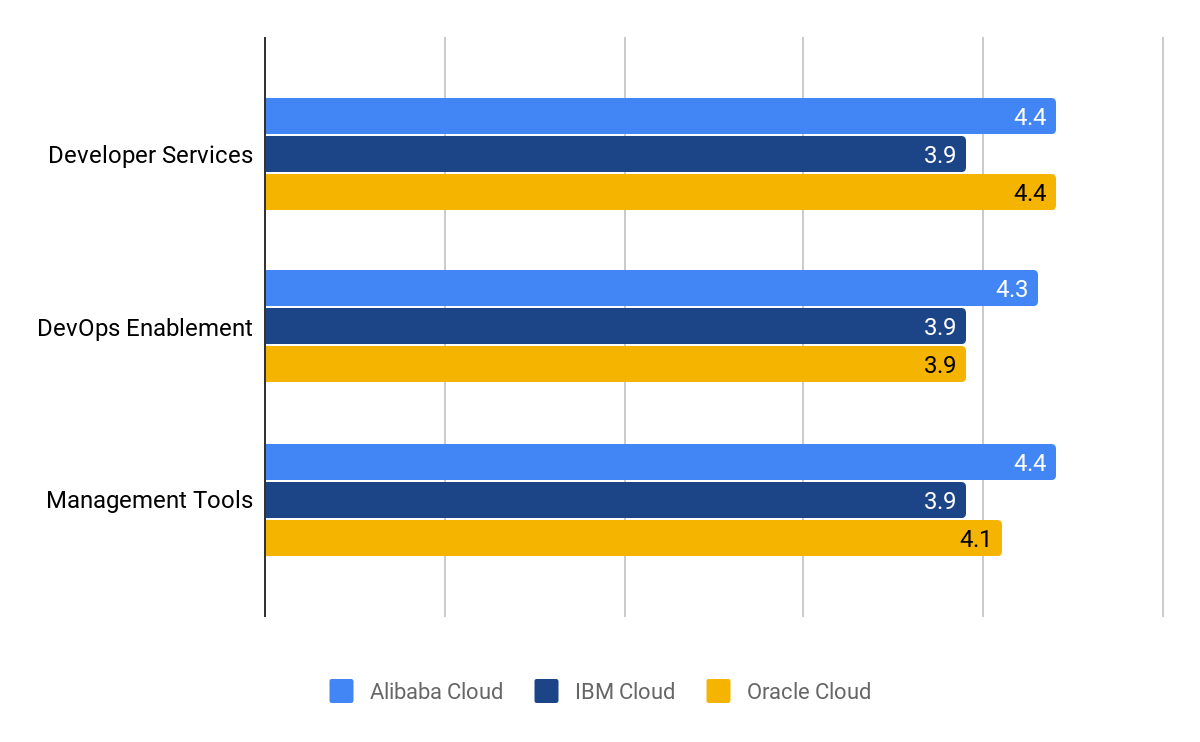
Figure 3: How users compare developer and management services across the three providers. Gartner
Security & Compliance
Public cloud providers have invested heavily in tools and services that help their customers secure their cloud apps and data as well as meet government or industry compliance regulations. In fact, the use cases that first drew enterprises to the public cloud were its backup and disaster recovery (DR) capabilities, providing robust and cost-effective business continuity in the face of accidental or malicious data loss, corruption, and exfiltration.
All three of the cloud providers we’re reviewing here encrypt data at-rest and in-transit as well as provide encryption key management services. Other security services include identity and access management (IAM), threat detection, compliance certifications, and more.
Alibaba
IBM
Oracle
DR & Backup
Threat detection & alerts
Advanced Data Technologies and Next-Generation Apps
We have already shown that Alibaba, IBM, and Oracle provide extensive support for databases, data warehousing, and data migration. These capabilities are the infrastructure for managing big data and moving it around so that advanced data technologies can be used to extract business value. All three cloud providers offer machine learning and AI platforms to meet their customers’ data mining, modeling, and analysis needs. Alibaba Cloud has an end-to-end Machine Learning Platform for AI and Oracle supports machine learning and AI in its Oracle Analytics Cloud. Perhaps the best known, however, is IBM’s pioneering Watson Machine Learning service, which includes the collaborative Watson Studio environment.
Similarly, all three providers support the highly distributed architectures of next-generation apps based on containers, microservices, and functions as a service (serverless), as outlined in the table below:
Alibaba
IBM
Oracle
Containers
Functions as a Service
IBM Cloud Functions, based on Apache OpenWhisk
AWS is considered the pioneer in terms of public cloud support for containers and functions as a service. Azure and Google Cloud Platform responded quickly with robust services of their own. Of the three cloud providers that we are reviewing here, IBM Cloud Functions is the serverless platform that is usually chosen to be compared with the big three. That having been said, all of them provide solid support for the latest app architectures.
Summary
All three providers offer a comprehensive range of resources and services for securely developing and deploying even the most advanced apps and services on a public cloud. Of the three, Alibaba is the only one that is born-in-the-cloud and it is also generally rated the highest in terms of flexibility and customer service. In addition, for companies doing business in Asia Alibaba clearly offers the most extensive infrastructure for that region. That having been said, the Oracle Cloud might be the best choice for companies seeking to modernize their legacy Oracle applications. Of course, if we look at the annual revenue run rate of the three, IBM is leading the pack.

Figure 4: 2018 Cloud Revenues of the Top Six Providers. Source: ZDNet
Which provider would you choose?
